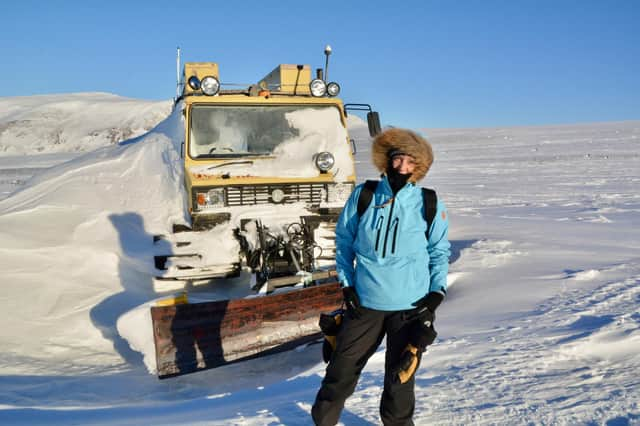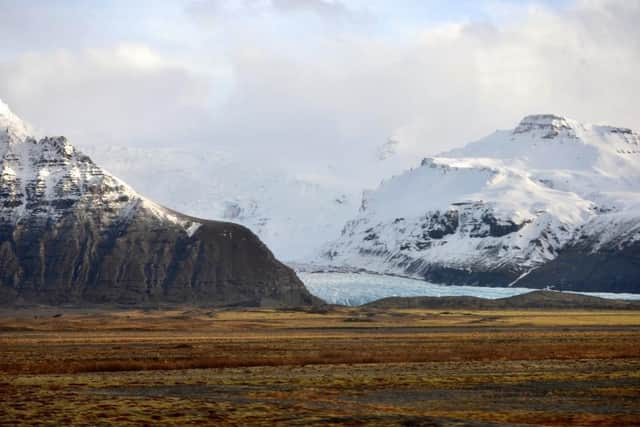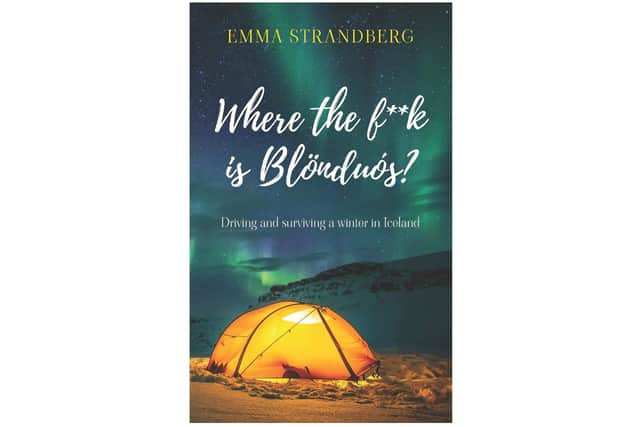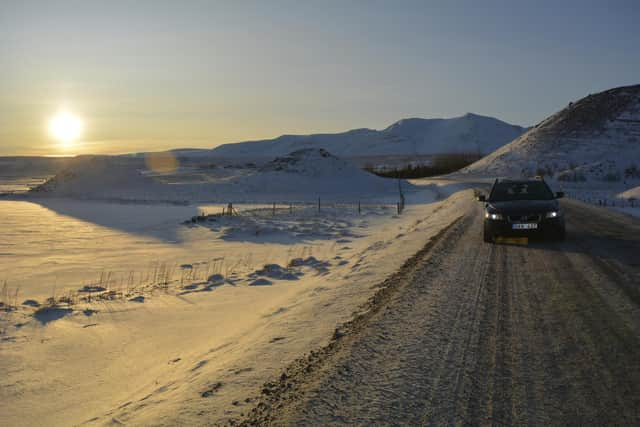Meet the author: Interview with travel author Emma Strandberg about her adventures in Iceland and latest book


Q. Of all places to find healing, why did you choose to go to Iceland?
A. I didn’t choose Iceland; Iceland chose me. An opening quote in Where the f**k is Blönduós? reads, “There are few things more powerful than destiny, few things fiercer than fate. I am therefore going to Iceland, more because of destiny than out of any personal desire.”
This is an extract from the Vatnsdæla Saga and it sums up exactly how I felt. I had grown up with tales of Iceland, and had been gifted my late mother’s journals written there during the early 1960s. Her first of two visits to Iceland coincided with the eruption of the volcanic island of Surtsey. My mother battled with depression and had suffered at the hands of my father. She had been heavily pregnant with my eldest sister when she first travelled to Iceland, and within hours of arriving to meet my father, who was working overseas, had been physically abused by him. She wrote a detailed account, which I couldn’t bear to read fully until I was almost 40 years old. Following the assault, she had sought help from the local hospital then proceeded to spend three weeks alone with just enough money for a guest house and food. She left only when her ticket home was due to expire.


Throughout my childhood, I was reminded that I was neither planned nor wanted. That sticks in your psyche. Iceland had provided my mother with a final taste of excitement and freedom, and she spent her life thereafter knowing what she was missing. I, too, had reached a stage in life where I was finding it difficult to cope. I had lived and worked overseas for many years, missing the support network of family and friends. I had been married to someone who worked away from home in conflict zones and felt as though I was suffering from vicarious stress. It was only a matter of time before we would divorce. Following a night-time break-in into my home, I finally reached a point where I could no longer put on a brave face. For me, Iceland felt as though I was taking myself back to the beginning, to where my own emotional difficulties had stemmed from and to move forward, I must first deal with forgiving the past.
Q. How did you come up with the book’s memorable title?
A. The truth is I had played with several titles and yet always came back to Where the f**k is Blönduós? No matter whom I spoke to before, during, or after my trip there, I was invariably asked “Where the f**k is Blönduós?” I hope it isn’t offensive to others, and that it is accepted in the spirit it is meant.
Q. What is your favourite passage in Where the f**k is Blönduós?, and why?


A. The chapter entitled ‘Hot Pots’ discusses me stripping off and bathing naked in the dark, alone, in a hot pot, having first dropped a local lady off at a goose party. It was early December and I had been in Iceland for around three and a half months by then. It had taken time for me to believe in myself and start enjoying my odyssey. As a woman of a certain age with a fear of water, and who prior to this journey had constantly worried about ‘what ifs’, I was abandoning all but my woolly hat, taking an ice-cold hosepipe shower then entering a warm hole in the ground. I remember thinking I was safe as I had closed the gate behind me when driving down the dirt track. Therefore, you can imagine my surprise when car headlights on full beam caught me like a trapped hare! It is moments like this that defined just how far I came in my own personal development. I felt refreshed, brave, and curious.
Q. What was the hardest chapter to write?
A. Whilst there is one chapter, ‘Manus I Mano’, that covers the loss of a dear friend while I was in Iceland, it was writing about an experience that nearly cost me my life – brought about by stupidity – that was most challenging for me. I had been walking and was tired, the weather was freezing cold, and I had injured my foot some weeks before. I have absolutely no idea why, but I attempted to climb a rocky outcrop which would mean a shortcut back to where I had left my car. I started to climb then lost my nerve, panicked, and was stuck. I couldn’t find a foot or handhold and felt myself slipping. I knew if I let go it would almost certainly end badly. To this day I have no idea how I managed to rescue the situation, but inch by inch I did drag myself up and over the cliff and onto terra firma. My hands and nails were bleeding, I had cut my head, and was in a state of shock. I got back to the car, swallowed two paracetamol tablets, and promptly vomited. It was a turning point in my journey in that I knew I wanted to live. My life may have been less than perfect, but I knew at that moment that no matter what it threw at me, I was willing to take it and more just to be alive.
Q. What was the most challenging part of writing your new book?


A. Processing my thoughts and emotions after returning home from Iceland. I had written several notebooks while there but knew that if the book was an honest representation of my personal journey then I had to expose my own vulnerabilities. I had never spoken about my own struggles and had to find the courage to do so. Several times I shelved the idea of publishing this book, but when I started writing the sequel, I knew that an important part of my journey was firstly having the courage to publish the full story. At the height of my own struggle with anxiety I visited a speech therapist regularly as my throat was tense and I had difficulty swallowing and eating. She helped me enormously in understanding both where and how I lived, together with the realisation that it had been the trauma that I had been through that had led to my body restricting my speech function. My voice had been taken from me but writing gave me it back. It did, however, take a long time to build up the strength to publicly acknowledge and share that voice.
Q. What can readers hope to learn from Where the f**k is Blönduós?
A. I hope that Where the f**k is Blönduós? offers a wealth of practical information to anyone considering a road trip to Iceland, or indeed anywhere. The planning stages are integral to the success of such a journey. My book provides an insight into many lesser-known parts of Iceland and the Icelandic culture. An important lesson I learned, and hope others can relate to, is that despite the events that happen throughout our lives that make us who we are, we have choices. We cannot control everything in life, but we can control how we react. To be the best version of ourselves brings us happiness, well-being, and focus. My book is very much about daring to dream, pushing ourselves to our limits, and loving who we are. If I can inspire one person to follow their dreams, break a cycle of destructive behaviour, or simply follow a path to renewed happiness then I have achieved what I set out to do.
Q. Where do you get your ideas on where to visit next?
A. Writing and reading, for me, has been a lifelong passion. I first started writing to get out of PE at school yet it took many years to realise that writing is what ‘makes me tick’. I adored poring over encyclopaedias and maps when I was a child, and was fortunate in that my family travelled and kept diaries. I have several unique stories to tell based on fact. It takes time as I juggle photography and ‘everyday work’ to support my writing.
Q. How do you discipline yourself to write?
A. That’s easy. I light a tea light candle daily and usually write until it burns down. On occasion I extinguish and relight it but over a 24-hour period I write a candle’s worth. I have been known to write two candles’ worth in a day. I always have a moleskin notebook and pencil in my pocket. It’s old fashioned but works for me. As a family we don’t exchange expensive presents though I receive notebooks for my birthday every year with the same card saying, “Maybe this year there will be a bestseller”.
Q. Why should people go to Iceland?
A. There is no doubt that Iceland is a unique brand, and it does a good job of marketing itself. Aside from that, no matter where in the world you live, there is nowhere that is comparable to Iceland. It is truly unique. Its diversity offers something for everyone. No matter your age, budget, capabilities, interests, or expectations, Iceland is doable, and it delivers. Allow yourself the opportunity to travel to Iceland and you will leave richer for the experience.
Q. How should they best prepare before they set off?
A. Read my book! Seriously, whether you plan to stay in the region of Reykjavik and take a handful of tours or are planning to see a wider part of the country, you will be much more prepared if you read of my experiences. Knowing in advance the difference between prjonakaffi and Þorrablót, Ástarpungar and Ástandið or understanding helpful road signs like ones advising of a one-way tunnel (Einbreið), you will be better prepared and have a richer experience.
Where the f**k is Blönduós? Driving and Surviving a Winter in Iceland by Emma Strandberg (New Generation Publishing) is out now on Amazon, priced £9.99 in paperback. An eBook version will be available soon, priced £5.99. For more information, visit www.emmastrandbergbooks.com.
Exclusive Extract From Where the f**k is Blönduós? By Emma Strandberg
To mark the publication of Where the f**k is Blönduós? by Emma Strandberg, here is an exclusive extract from the chapter ‘Manus I Mano’, detailing the loss of her close friend Mats, and how his passing motivated her to find new strength and overcome her fears in taking on the harsh Icelandic winter on a solo camp.
Three days passed before I showered and dressed. Distance and solitude were again my best friends. I hoped he knew I loved him. I knew he had loved me.
As I thought more about the phone call and the evening prior to it, was it a coincidence that I had my palm read in Skagaströnd? Life could indeed be stranger than fiction, and I couldn’t deny the synchronicity between the two events. It was as though I had been forewarned, and from somewhere within, I must now find strength.
I didn’t return home for the funeral. I chose instead to do what I thought Mats would approve of, that was, to carry on and face down challenges along the way. And so, despite my pain, I felt motivated. My time was limited in Iceland, and I would continue to make each day count. I had faced obstacles after arriving, both perceived and real. The road conditions and wind had taken me by surprise, and I realised too that changing our geography didn’t change our history. The artists complimented me daily on how brave I was to be here alone for so many months, while the locals thought I was simply as mad as a box of frogs, though praised me for writing a book.
Dressed and packed, I looked briefly out the window and saw the waves moving horizontally across the sea. It was blowing a hooley as usual. I had checked the weather app, and it had said a strong breeze in the north, with clouds making way for a little sun after midday.
Anyone would tell you if you didn’t like the weather in Iceland, wait five minutes. At times, this was true. I took my bags to the car with everything I thought I might need, including my tent which I’d decided wasn’t going to stay packed in the bottom of the small wardrobe any longer. I had a vague idea where I was heading. While it was recommended to use camping sites where possible throughout the country, you could camp for one night with a maximum of three tents off-site, though you did need to seek the landowners’ permission beforehand.
Literally from walking the short distance from the parked car to the supermarket, no more than six minutes, I had gone from standing upright to being bent double against the wind and trying to shelter my eyes from gravel.
My first solo camp would be an easy drive from Blönduós. That way, if I did run into difficulties, I wasn’t too far from home. It was questionable why I would set off with a tent in the middle of winter in Iceland, having not trialled all the equipment first. I had meant to, but having brought the trip forward by a month, there simply hadn’t been time. I was not an experienced camper but I have camped several times in Scotland, Wales, and Scandinavia in wintertime, though rarely alone. I had invested in my new tent, knowing it was good quality, warm, light, and easily manageable. It claimed to be worthy of any expedition, and in the Icelandic north, this was indeed one of those! When I had paid the heavy price tag, I deduced that I was going to trust my life in it. A tent kept you warm and dry, but especially in wintertime, that meant safe and even alive. I was ill-prepared for the temperamental weather Iceland threw at me; the high winds especially, though I was confident the Kerlon 1800 material which the outer fabric was made from would stand up to the elements. It was the polar bears I was more afraid of. Mats had desperately wanted me to buy this tent, and I was now glad I had listened. We had even named it together on our way home from our shopping trip. We had named her Bothy, meaning shelter.